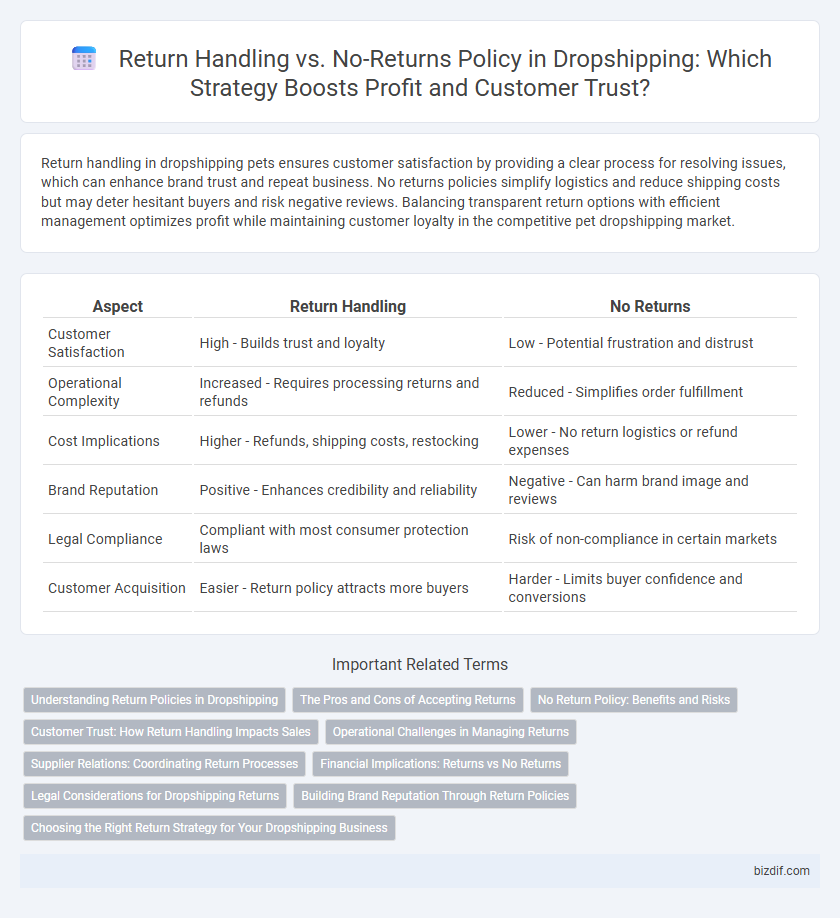Return handling in dropshipping pets ensures customer satisfaction by providing a clear process for resolving issues, which can enhance brand trust and repeat business. No returns policies simplify logistics and reduce shipping costs but may deter hesitant buyers and risk negative reviews. Balancing transparent return options with efficient management optimizes profit while maintaining customer loyalty in the competitive pet dropshipping market.
Table of Comparison
| Aspect | Return Handling | No Returns |
|---|---|---|
| Customer Satisfaction | High - Builds trust and loyalty | Low - Potential frustration and distrust |
| Operational Complexity | Increased - Requires processing returns and refunds | Reduced - Simplifies order fulfillment |
| Cost Implications | Higher - Refunds, shipping costs, restocking | Lower - No return logistics or refund expenses |
| Brand Reputation | Positive - Enhances credibility and reliability | Negative - Can harm brand image and reviews |
| Legal Compliance | Compliant with most consumer protection laws | Risk of non-compliance in certain markets |
| Customer Acquisition | Easier - Return policy attracts more buyers | Harder - Limits buyer confidence and conversions |
Understanding Return Policies in Dropshipping
Return handling in dropshipping requires clear communication of return policies to minimize disputes and maintain customer trust. Understanding return policies involves evaluating supplier terms, restocking fees, and shipping costs to ensure profitability while offering fair customer service. Choosing between return handling and no returns impacts customer satisfaction, operational complexity, and overall business scalability.
The Pros and Cons of Accepting Returns
Accepting returns in dropshipping enhances customer trust and satisfaction, potentially increasing repeat sales, but it also introduces logistical complexities and additional costs such as restocking fees and shipping expenses. No returns policies simplify operations and reduce overhead but may deter customers wary of product quality or fit, risking lower conversion rates. Balancing customer experience with operational efficiency is critical for optimizing profitability in dropshipping businesses.
No Return Policy: Benefits and Risks
Adopting a no return policy in dropshipping reduces logistics costs and simplifies inventory management by eliminating the need to process returns or restock products. This approach minimizes customer service workload and can lead to faster order fulfillment, but it risks damaging customer trust and discouraging purchases if buyers feel uncertain about product quality or satisfaction guarantees. Businesses must balance cost savings with potential impacts on brand reputation and customer loyalty in selecting a no return policy.
Customer Trust: How Return Handling Impacts Sales
Effective return handling in dropshipping significantly enhances customer trust by demonstrating commitment to satisfaction, which can lead to increased repeat purchases and positive reviews. Transparent and hassle-free return policies reduce buyer hesitation, directly impacting conversion rates and overall sales performance. Conversely, no returns policies often deter potential customers, resulting in lower trust levels and diminished revenue potential.
Operational Challenges in Managing Returns
Managing returns in dropshipping introduces operational challenges such as coordinating reverse logistics, handling restocking processes, and ensuring timely refunds to maintain customer satisfaction. No returns policies simplify operations by eliminating the need for return shipping management and inventory restocking but can decrease buyer confidence and reduce conversion rates. Efficient return handling requires robust communication between suppliers, carriers, and customers to minimize delays and financial losses.
Supplier Relations: Coordinating Return Processes
Efficient return handling in dropshipping enhances supplier relations by establishing clear communication and streamlined processes for product returns, reducing disputes and delays. Coordinated return procedures ensure suppliers promptly address defective or incorrect items, maintaining customer satisfaction and trust. Choosing suppliers that offer transparent, consistent return policies minimizes conflict, allowing smoother operations and long-term partnership growth.
Financial Implications: Returns vs No Returns
Return handling in dropshipping involves additional costs such as restocking fees, shipping expenses, and potential loss of product value, which can significantly impact profit margins. In contrast, a no returns policy reduces operational expenses but may deter customers and decrease repeat business, affecting long-term revenue growth. Balancing return policies requires analyzing customer satisfaction metrics against financial data to optimize profitability and minimize losses.
Legal Considerations for Dropshipping Returns
Dropshipping return policies must comply with consumer protection laws, which vary by jurisdiction and dictate clear guidelines on return eligibility, timeframes, and refund processes. Sellers should outline transparent return procedures in their terms and conditions to avoid disputes and potential legal liability related to defective or incorrect products. Ensuring compliance with regulations such as the Consumer Rights Directive (EU) or the Federal Trade Commission's rules (US) helps maintain trust and reduces the risk of fines or legal action in dropshipping operations.
Building Brand Reputation Through Return Policies
Efficient return handling in dropshipping builds customer trust by demonstrating commitment to satisfaction and product quality, enhancing brand reputation. Offering clear, hassle-free return policies reduces purchase hesitation and encourages repeat business, positioning the brand as reliable and customer-focused. In contrast, no-return policies risk negative reviews and diminished customer loyalty, ultimately harming long-term brand value.
Choosing the Right Return Strategy for Your Dropshipping Business
Selecting the appropriate return strategy in dropshipping significantly impacts customer satisfaction and profit margins. Implementing a return handling policy can build trust and reduce refund disputes, but it often increases operational costs and complexities. Alternatively, adopting a no-return policy simplifies logistics and cuts costs, yet risks alienating customers seeking flexibility and confidence in their purchase decisions.
Return Handling vs No Returns Infographic

 bizdif.com
bizdif.com